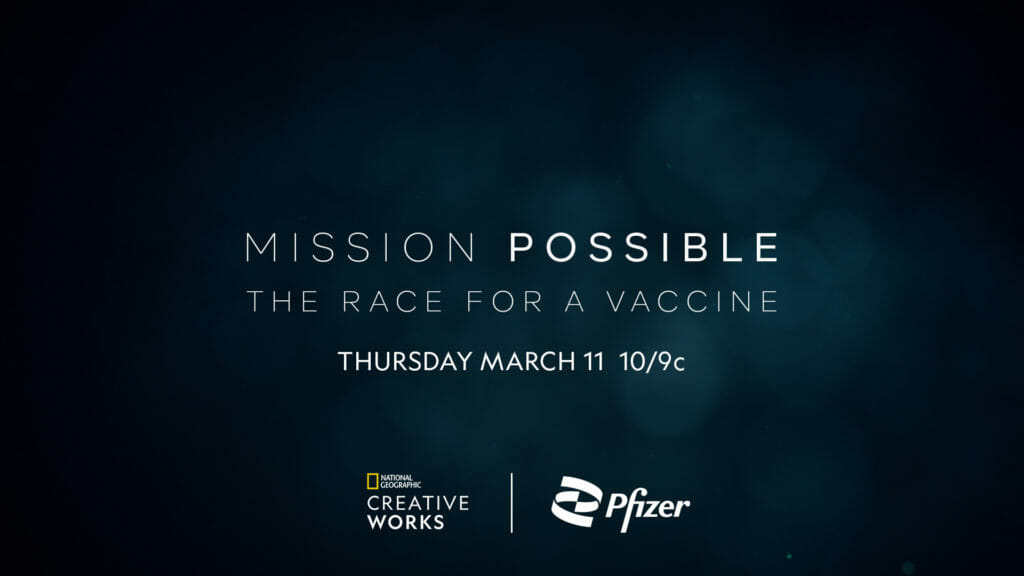It was February 2020 and Pfizer CEO Albert Bourla recognized that life as we knew it was soon to be upended. As details about the mysterious virus overwhelming Wuhan filtered in — and the seriousness of the threat it posed quickly became evident, the CEO and the company he led set about developing a vaccine to combat it.
That process ultimately concluded on Friday, December 11, when the U.S. Food and Drug Administration approved the Pfizer/BioNTech COVID-19 mRNA vaccine for emergency use. By any standard, the development and testing of a vaccine in such a short time span represented a scientific triumph as unprecedented as the crisis that birthed the need for it.
As it turns out, cameras captured many of the behind-the-scenes trials and tribulations. The resulting film, Mission Possible, debuts on National Geographic on Thursday March 11 — the one-year anniversary of the World Health Organization’s pandemic declaration — at 10 p.m. ET.
To hear Pfizer EVP and chief corporate affairs officer Sally Susman tell it, the project represented a true leap of faith.
“It had to come together very, very quickly,” she recalled. “We committed to participating in this documentary before we had any idea whether our vaccine would be successful, before we knew we would be the first to market. We began working on it even before we finalized the contract details with National Geographic.”
National Geographic — through its CreativeWorks arm, a part of Disney Advertising Sales’ Disney CreativeWorks group — was a natural partner for the project.
“I think of National Geographic as a scientific organization — an organization that has journalistic integrity but also that scientific understanding,” Susman said. “Once we thought we might be doing something special and wanted to preserve it for our colleagues and for history, they were the first call. They wanted to act with the same urgency in telling the story as we did in discovering the vaccine.”
Mike Wiese, SVP of branded content at National Geographic Partners and Disney CreativeWorks, pointed to that urgency as one of the project’s major draws — and one of its major challenges. “We didn’t have a couple of years to figure it out, you know?” he noted.
Then there was the matter of COVID production protocols — which, owing to the March/April start date of Mission Possible, hadn’t yet been formalized. Wiese characterized the early days of filming as “that kind of building-a-plane-and-flying-it-at-the-same-time cliché,” crediting the organization’s production partner for its role in managing the imposing logistics.
“There were limits to where we could go and the rooms we could go in. It was a small production footprint,” Wiese added.
Those limits, however, didn’t apply to individual access. Among others, the filmmakers spent time with Bourla, Johnson & Johnson chairman and CEO Alex Gorsky, and a range of scientists, factory workers and clinical trial participants. Given the restrictions in terms of where filming could take place — “I worried the film might lack energy and dynamism, because we could only be in the laboratories and factories so much,” Susman said — the individual testimony lends the film a thoughtfulness and intimacy often missing from science-minded material.

And while Mission Possible is technically branded content, Pfizer adopted a hands-off approach to the project. While Susman viewed footage and asked questions during the production process, both she and Wiese stressed that the final cut belonged to the filmmakers.
“We presented to them what we thought the story was, and that’s what we produced,” Wiese said. Susman agreed, adding, “A film like this is not going to work if there are bright lines you can’t cross over. If you’re going to do it, you do it. You let the crew have the access they need and have faith that your people and facilities and outcomes will stand on their own.”
At the outset of filming, nobody knew whether Pfizer’s effort to develop a vaccine would succeed. When Mission Possible airs on Thursday night, however, that central will-it-or-won’t-it question can no longer serve as a plot point. It’s a credit to the filmmakers, then, that even with the outcome no longer in doubt, they manage to sustain the dramatic tension.
“We began not knowing what the results were going to be,” Wiese said. “Really, that’s what made Pfizer a great partner on this, because they were willing to embrace that. There could’ve been bad news for them and the film would’ve taken another direction.”
Asked whether Pfizer had considered that possibility, Susman laughed. “We did, but come on — we were already out there! Our CEO had made a very public pledge that we were going to attempt to have a vaccine by the end of the year, that we were going to attempt to make the impossible possible,” she explained. “With that level of ambition already expressed, doing the film seemed an appropriate measure. It was a digestible risk.”
As for what comes next, Susman said Pfizer would “absolutely” entertain the possibility of once again opening its doors to documentary filmmakers. “Discovering cures and treatments, whether in oncology or pain or anywhere else, is a worthy pursuit. The work we do has a lot of inherent drama,” she noted.
Wiese similarly hopes his National Geographic team will have other opportunities to work on pharma- and health-related film projects. “This was obviously a once-in-a-lifetime story — well, hopefully it’s just once in a lifetime — and we were fortunate to be able to document that. We’d be thrilled if it opens up doors to other brands who want to tell their story.”








